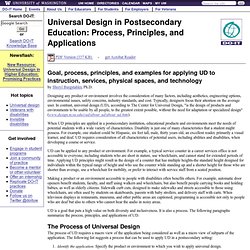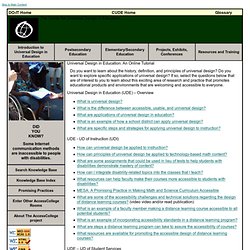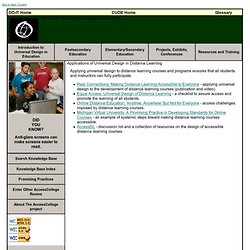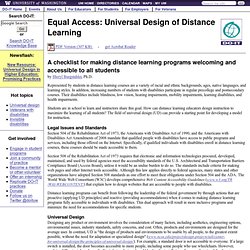

UDL Guidelines Graphic Organizer. This graphic is also available in PDF format.

UDL Guidelines graphic organizer text despcription This graphic organizer of the Universal Design for Learning Guidelines depicts the three main principles of UDL in three color-coded columns with numbered explanations and bulleted examples beneath each principle heading. Principle I. Provide Multiple Means of Representation is shown on the left in dark pink and includes the following: What are the benefits of universal design of a distance learning course for students without disabilities? People without disabilities may have temporary and/or situational limitations that are similar to the limitations imposed by disabilities.

For example, people who cannot access graphics due to computer system limitations are in a situation similar to that of students who are blind. A noisy environment that prohibits the use of audio features imposes constraints similar to those faced by students with hearing impairments. Those for whom English is a second language experience reading difficulties similar to those experienced by people with some types of learning disabilities. Individuals using monochrome monitors face limitations similar to those faced by students who are color-blind. People who need to operate a computer but whose hands are occupied with other activities face challenges similar to those faced by individuals who use a hands-free input method because of a disability. Universal Design in Postsecondary Education: Process, Principles, and Applications. PDF Version (337 KB) - get Acrobat Reader Goal, process, principles, and examples for applying UD to instruction, services, physical spaces, and technology by Sheryl Burgstahler, Ph.D.

Designing any product or environment involves the consideration of many factors, including aesthetics, engineering options, environmental issues, safety concerns, industry standards, and cost. Typically, designers focus their attention on the average user. In contrast, universal design (UD), according to The Center for Universal Design, "is the design of products and environments to be usable by all people, to the greatest extent possible, without the need for adaptation or specialized design" (www.design.ncsu.edu/cud/about_ud/about_ud.htm).
When UD principles are applied in a postsecondary institution, educational products and environments meet the needs of potential students with a wide variety of characteristics. UD can be applied to any product or environment. Real Connections: Making Distance Learning Accessible to Everyone. PDF Version (466 KB) - get Acrobat Reader by Sheryl Burgstahler, Ph.D.

Distance learning has been around for a long time. For hundreds of years instructors have taught students across great distances via correspondence courses using printed materials. The early days of television witnessed the introduction of televised courses. Today, an instructor can videoconference with several classrooms full of students. Increasing access to more students is a common reason given for providing instruction in a distance learning format. Ensuring that individuals with disabilities can participate in distance learning courses can be argued on ethical grounds. The following paragraphs discuss access issues and present design considerations for ensuring that a course is accessible to potential instructors and students with a range of abilities and disabilities. Access Barriers Blindness A student or instructor who is blind may use a computer equipped with text-to-speech software. Other Visual Impairments.
Universal Design in Education: An Online Tutorial. Skip to Main Content DO-IT Home | CUDE Home | Glossary.

Universal Design of Distance Learning Courses. As you prepare to deliver preservice or inservice instruction regarding universal design of distance learning courses, the sample presentation may be helpful.

Consider including this content along with other diversity issues related to gender and race/ethnicity. Purpose After this presentation, participants will be able to define universal design, list universal design principles, list ways that universal design principles can be used to make a more inclusive distance learning course, and describe the difference between employing universal design principles to maximize access and providing accommodations for students with disabilities. Length Approximately 60 minutes. Presenter. Applications of Universal Design in Distance Learning. Skip to Main Content DO-IT Home | CUDE Home | Glossary The Center for Universal Design in Education Introduction to Universal Design in EducationPostsecondary EducationElementary/Secondary EducationProjects, Exhibits, ConferencesResources and Training Anti-glare screens can make screens easier to read.

Equal Access: Universal Design of Distance Learning. PDF Version (307 KB) - get Acrobat Reader by Sheryl Burgstahler, Ph.D.

Represented by students in distance learning courses are a variety of racial and ethnic backgrounds, ages, native languages, and learning styles. In addition, increasing numbers of students with disabilities participate in regular precollege and postsecondary courses. Their disabilities include blindness, low vision, hearing impairments, mobility impairments, learning disabilities, and health impairments. Students are in school to learn and instructors share this goal. Legal Issues and Standards Section 504 of the Rehabilitation Act of 1973, the Americans with Disabilities Act of 1990, and the Americans with Disabilities Act Amendments of 2008 mandate that qualified people with disabilities have access to public programs and services, including those offered on the Internet.